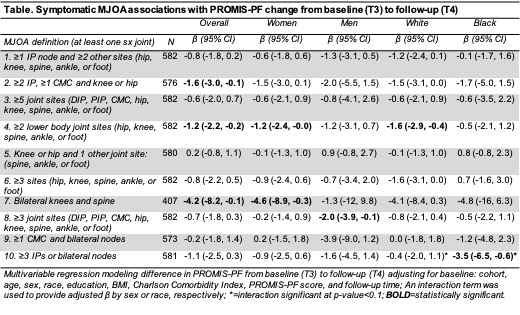Session Information
Session Type: Poster Session A
Session Time: 8:30AM-10:30AM
Background/Purpose: To determine the differential effects of several literature-based definitions of multi-joint osteoarthritis (MJOA) on change in self-reported physical function in a community-based cohort.
Methods: We previously defined 10 forms of MJOA (Table) based on results from a systematic review of MJOA definitions (PMID 30390991). Here, we focus on the influence of symptomatic MJOA (sxMJOA, i.e., meeting a given MJOA definition with at least one site being symptomatic, see Table) on change in physical function 3.5 years later. The outcome of interest was the change in scores on the Patient Reported Outcomes Measurement Information System Physical Function Scale, Short Form 10a version 1.0 (PROMIS-PF, PMID 21914216). Data were from participants in the Johnston County OA Project (JoCoOA) who completed the baseline (T3; 2013-15) and follow-up (T4; 2017-18) visits and had data for both baseline sxMJOA and PROMIS-PF scores at baseline and follow-up.
Multivariable linear regression models were performed to assess the association of sxMJOA definitions with PROMIS-PF change from baseline to follow-up, adjusting for baseline: cohort, age, sex, race, education, body mass index (BMI), Charlson Comorbidity Index, PROMIS-PF score, and follow-up time. β and 95% confidence intervals for sxMJOA are reported , with negative values representing greater reduction in PF in those with sxMJOA . An interaction term was included in the model to provide estimates by sex or race, respectively; as these stratified results were of particular interest, they are reported regardless of statistical significance of this term.
Results: Included individuals (n=586, 71% women, 36% Black) had a mean age of 70 ± 7 years and mean body mass index (BMI) of 32 ± 7 kg/m2 at baseline. Depending on the definition, the prevalence of sxMJOA ranged from 1 to 51%. Overall PROMIS-PF scores declined (worsened) by about 1 point (mean -1.2 [SD 6.4]) over the 3.5 ± 1 year follow-up, with 53% of individuals experiencing a worsening in score.
Statistically significant decreases in PROMIS-PF scores were seen overall for those with sxMJOA-2, -4, and -7 (Table). The effects of sxMJOA-1, -2, -4 and -5 were similar across sex and race. The largest effect on PROMIS-PF (4–5-point reduction) was from the relatively infrequent sxMJOA-7 (involvement of the bilateral knees and spine), an effect that was strongest in women and Blacks. Men with sxMJOA-8 had reductions in PF not seen in women or by race. sxMJOA-10 (interphalangeal hand OA) was associated with significantly poorer PF scores only in Black participants (3.5-point reduction, p< 0.1 for interaction). sxMJOA-3, -6, and -9 were not associated with PF changes, nor were sums of affected joint sites (data not shown).
Conclusion: Specific subtypes of sxMJOA in which at least one joint site is symptomatic are associated with varying decrements in self-reported physical function, beyond simple summing of affected numbers of joints. In some cases, important differences by sex and race are observed. These findings suggest the importance of MJOA phenotypes, future work will include other physical function measures, both self-reported and performance-based, and longer follow-up times.
To cite this abstract in AMA style:
Nelson A, Alvarez C, Arbeeva L, Renner J, Kraus V, Lascelles D, Golightly Y. Effects of Multi-Joint Osteoarthritis Phenotypes on Self-Reported Physical Function over 3.5 Years: The Johnston County Osteoarthritis Project [abstract]. Arthritis Rheumatol. 2021; 73 (suppl 9). https://acrabstracts.org/abstract/effects-of-multi-joint-osteoarthritis-phenotypes-on-self-reported-physical-function-over-3-5-years-the-johnston-county-osteoarthritis-project/. Accessed .« Back to ACR Convergence 2021
ACR Meeting Abstracts - https://acrabstracts.org/abstract/effects-of-multi-joint-osteoarthritis-phenotypes-on-self-reported-physical-function-over-3-5-years-the-johnston-county-osteoarthritis-project/

